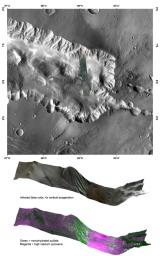
|
Eolian Features Provide a Glimpse of Candor Chasma Mineralology
- Click the image above for a larger view
- Full-Res JPEG (1126 x 1800) (267.1 kB)
- Full-Res TIFF (1126 x 1800) (6.1 MB)
Caption:
This image of Candor Chasma's eastern end was taken by the Compact Reconnaissance Imaging Spectrometer for Mars (CRISM) at 0655 UTC (2:55 a.m. EDT) on March 24, 2007. CRISM's image captured 544 colors covering 0.36-3.92 micrometers, and shows features as small as 100 meters (330 feet) across. The region covered is roughly 10 kilometers (6.2 miles) at its narrowest point. Designed to look for a variety of materials on the walls and floor of Candor Chasma, this CRISM observation is somewhat unique in that it is extended along an extended path across the chasma floor to capture extra territory at the expense of spatial resolution.
Candor Chasma is a deep, elongated, steep-sided depression some 813 kilometers (505 miles) in length. It is one of two large chasmata that make up the northern end of the Valles Marineris system. The top image, which illustrates the long path CRISM's cameras scanned to extend the observation in the along-track direction, shows the CRISM image on top of a mosaic of images from the Thermal Emission Imaging System (THEMIS) on Mars Odyssey. The lower two false-color images offer a glimpse of the topography and mineralogy contained within this large chasma. These views were constructed by draping the CRISM images over topography, and viewing the surface in perspective from the northeast. The southern part of CRISM's swath (to the left) covers interior layered deposits along with low ridges (far left) that are an erosional remnant of the chasma wall. The northern end (to the right) reveals the older, eroded chasma wall material, as well as the chasma floor. White lines in the images represent gaps in the data due to the stretching of the image.
The erosive Martian wind appears to have removed dust and debris covering monohydrated sulfate-rich mineral deposits (bright green). Wind-abraded ridges of layered sediments (image center) reveal these deposits more readily, while ridges to the north and south also appear to retain more of a cover of obscuring dust.
Background Info:
CRISM is one of six science instruments on NASA's Mars Reconnaissance Orbiter. Led by The Johns Hopkins University Applied Physics Laboratory, Laurel, Md., the CRISM team includes expertise from universities, government agencies and small businesses in the United States and abroad. NASA's Jet Propulsion Laboratory, a division of the California Institute of Technology in Pasadena, manages the Mars Reconnaissance Orbiter and the Mars Science Laboratory for NASA's Science Mission Directorate, Washington. Lockheed Martin Space Systems, Denver, built the orbiter.
Cataloging Keywords:
| Name | Value | Additional Values |
|---|---|---|
| Target | Mars | |
| System | ||
| Target Type | Planet | |
| Mission | Mars Reconnaissance Orbiter (MRO) | 2001 Mars Odyssey, Mariner, Mars Science Laboratory (MSL) |
| Instrument Host | Mars Reconnaissance Orbiter | Curiosity Rover, Mars Odyssey |
| Host Type | Orbiter | Flyby Spacecraft, Rover |
| Instrument | Compact Reconnaissance Imaging Spectrometer for Mars (CRISM) | |
| Detector | ||
| Extra Keywords | Color, Dust, Thermal | |
| Acquisition Date | ||
| Release Date | 2008-01-04 | |
| Date in Caption | 2007-03-24 | |
| Image Credit | NASA/JPL/JHUAPL/ASU | |
| Source | photojournal.jpl.nasa.gov/catalog/PIA10223 | |
| Identifier | PIA10223 | |
